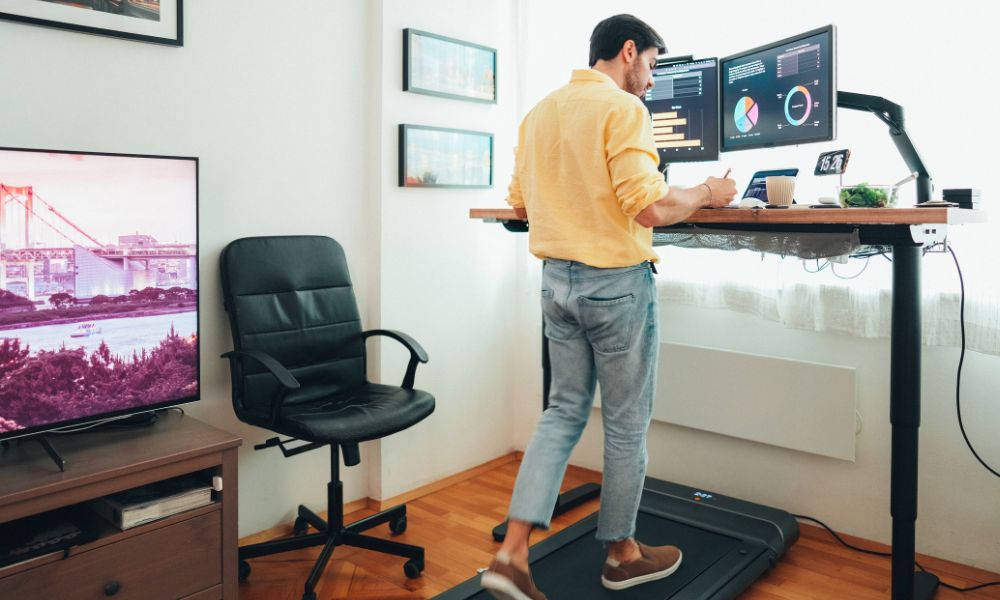Updated on 29/04/2024
"Sitting is the new smoking", this expression is the result of the last years of research on sitting.
The average adult sits a minimum of 8 hours a day, in transportation, at work, while eating, in the waiting room, at the bar, and so on. Unfortunately, many ills are attributed to this bad habit- such as risks of a sedentary lifestyle. These may include cardiovascular risks due to inactivity.
Indeed, humans are not designed to sit for long periods of time. Researchers have noted that sitting increases the risk of suffering from certain cancers, heart disease and diabetes.
These health issues are the reason why companies like Facebook and Google provide standing desks for their employees to take advantages of the benefits of working in the standing position. Indeed, this alternative to sitting is becoming increasingly popular. One of its undeniable advantages is that it works large muscle groups, boosts your metabolism and burns more calories than sitting.
In addition, when you work standing up, you are taking care of your lower back: it is under half the pressure of sitting at your desk. Interestingly, when we look back in history, we learn that many famous people already preferred to work standing up, among the most famous are Winston Churchill, Napoleon and many others.
In this article, you will learn how to stand the right way at a standing desk, 5 great reasons to work in the standing position, and the answer to the most important questions about electric standing desks (and manual standing desks).
Need some help choosing the perfect standing desk for your home or commercial office? Get in touch with our experts on 02080640064.
How to Stand at a Standing Desk: Guide and Tips
In order to adopt the right position when you work standing up, you will first have to choose the right desk height, the one that best suits your body and your working habits. By using a handle, a crank (for manual standing desks) or simply buttons (for electric standing desks), you can adjust the height until you find the one that suits you best.
So, what is the right height for a sit stand desk and how do you get it? We have the answer. To find the best posture when working in the standing position:
- Your elbows should be at an angle close to 90 degrees, so that your keyboard is accessible, but not leaning over it. This is actually the only 90° angle you should be careful to maintain throughout your workday. Your forearms should be at this right angle so that they can be positioned on the tabletop without strain or discomfort.
- When adjusting the height of your sit-stand desk, make sure your back is straight. Don't get used to working with too much forward or backward bending, or you may develop lumbago or neck pain.
- Raise your computer screen to eye level. Most people place their screens too low, which strains the back and neck muscles to support the tilt of the head. And heads are heavy - they make up 8% of our body weight! The top of your screen should be slightly below your eye level, and it should be tilted at around 20 degrees backwards.
- Your feet should be flat on the floor, slightly apart and in line with your hips. Your toes should be pointed towards your desk. This will keep your head and your whole body in an upright and slender position.
In order to relieve your feet, muscles and joints, you can place an anti-fatigue mat on the floor. It will provide your feet with a soft space, thus reducing fatigue, especially if you have to stand for a long time.
A treadmill is also an interesting option. This is not a joke, it's a bit more complex but you may have seen some of these before.

While some people might find it harder to focus this way, it's possible to do some routine tasks while walking on a treadmill.
5 Advantages of Working in a Standing Position
We don't always think about it, but working standing up is an option, even when you're behind a stand-up desk! Here is a list of the advantages of working in an upright position:
1. Working while standing helps to avoid sedentary work
Another major problem of prolonged sitting (and of our modern world in general) is the lack of physical exercise! Our lifestyle has become far too sedentary for our health, especially for office workers. Work should normally be a time of activity, allowing us to expend ourselves, both physically and mentally. Thanks to a standing desk, and the upright posture, we can minimize the risks associated to a sedentary lifestyle.
2. Increase productivity
It is well known that sitting down tends to make us fall asleep, especially after a meal or if we have had a bad night. In these conditions, you risk working in slow motion, being less attentive, less focused. Staying upright as much as possible can increase your productivity at your job, keeping you more alert throughout the day.
3. Relieves back pain
Lumbago (Lower back pain) is one of the main sources of medical consultation and, in the most serious situations, the reason for sick leave, work interruption and career changes. In fact, between 6 to 10% of work interruptions are related to lumbago or a herniated disc. For people who work regularly at a desk, the risks can be drastically reduced by adopting good posture and ergonomic furniture, hence a standing desk such as the Atlas Standing Desk.
4. Gives you more energy
A sedentary lifestyle results in increased depression and anxiety in people. Standing prevents you from going into lethargic phases. You become extremely dynamic and your stamina does not drop during the day. You will notice an improvement in your mood after a few weeks. Indeed, keeping the same level of energy during the day allows you to face difficulties in a more optimistic way and it has a positive effect on your state of mind.
5. Lose weight and reduce the risk of diabetes
More convenient and less expensive than a gym! Not everyone has the time to get the required 40 minutes of physical activity every day. Standing allows you to overcome this problem and allows you to lose more calories.
Indeed, when you adopt the upright position, you can burn between 100 and 200 calories per hour (the number of calories you burn depends of your age, gender, height, and weight. Blood sugar levels and glucose levels in general drastically increase the risk of diabetes.

Standing for 1 to 2 hours at work after lunch has been found to reduce blood sugar levels in workers, compared to seated employees.
How Long Should I Stand When Using Height Adjustable Desks?
To get started, it is strongly suggested that you stand at height adjustable desks for intervals of no longer than thirty to sixty minutes at a time. Another method to calculate the amount of time you spend in the standing position is to estimate that you sit for approximately an hour for every hour or two that you stand. As soon as your body has adjusted to these new conditions, you will be able to stand for longer periods of time.
Is it Healthier to Work at a Standing Desk as Opposed to Sitting?
Because of the numerous positive effects on one's health that they have, modern workplaces are increasingly adopting the use of height adjustable desks or standing desks. According to a number of studies, the caloric spend while standing as opposed to sitting is significantly higher. Because sitting for extended periods of time causes muscles to contract, weigh gains, cancer, diabetes, and more, sit stand desks are another way to alleviate low back pain, and boost your productivity.
Conclusion
Looking for a standing desk for your home, office or workspace? Check out our full collection of standing desks, available for next working day delivery if ordered by 3pm. Our desks come with a 7 year warranty, 30 day risk free return, as well as access to a UK-based customer service team to answer any questions that you might have.
Otherwise, our desk blog provides more useful tips on using a standing desk for a more balanced lifestyle. Feel free to contact us with any questions, with the handy live chat feature on our site, or via email at info@ergodesks.co.uk.

